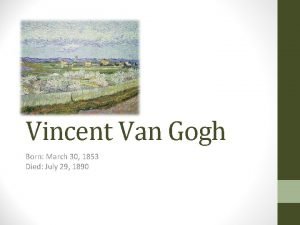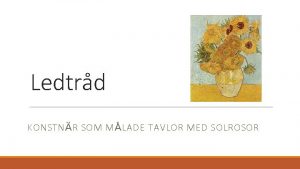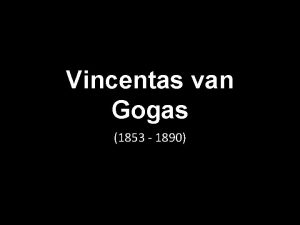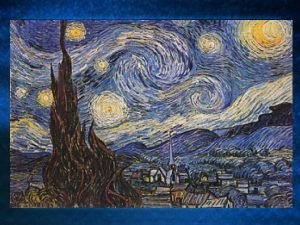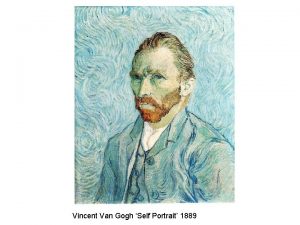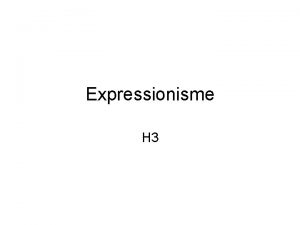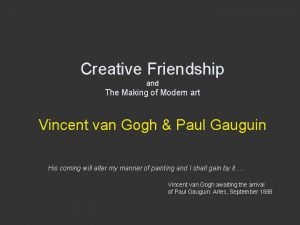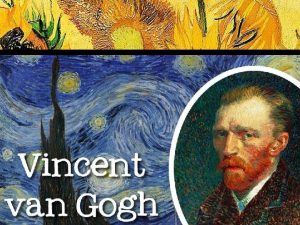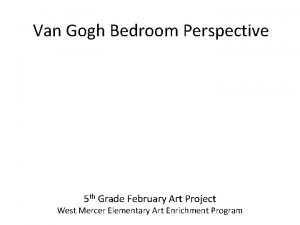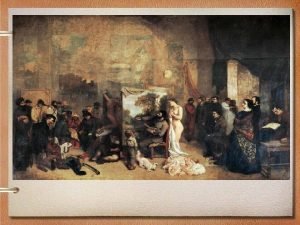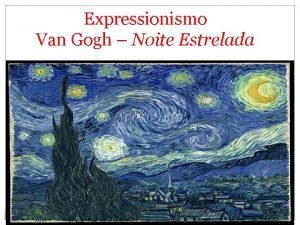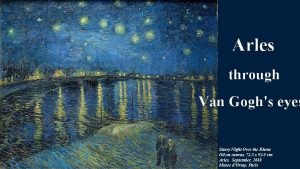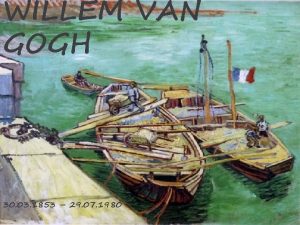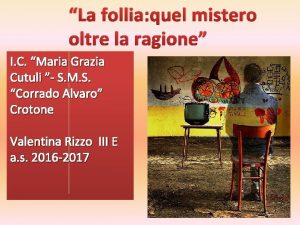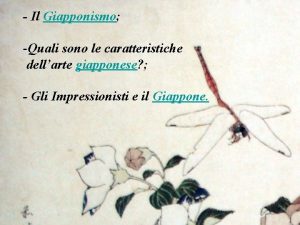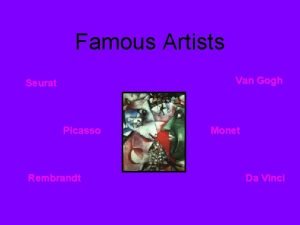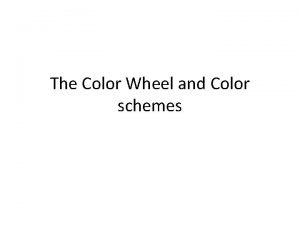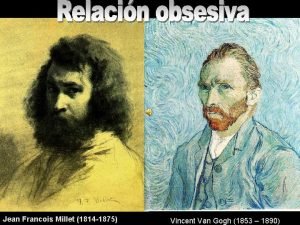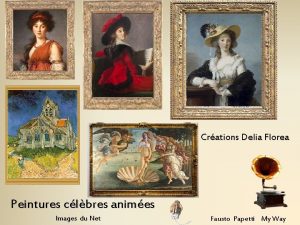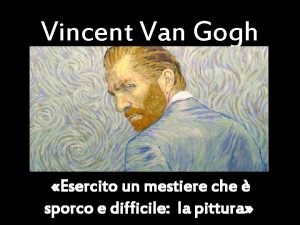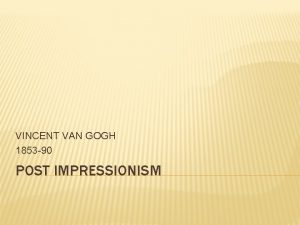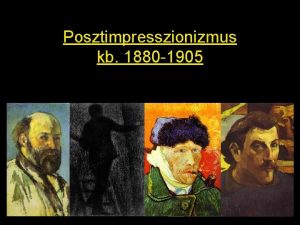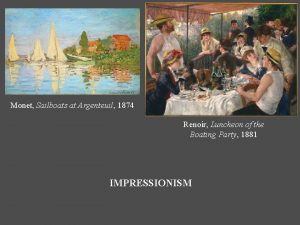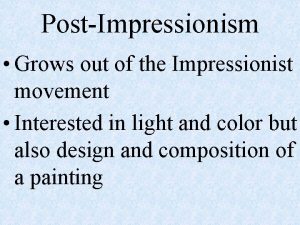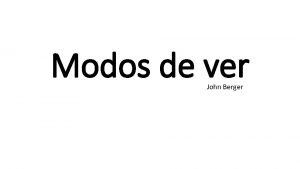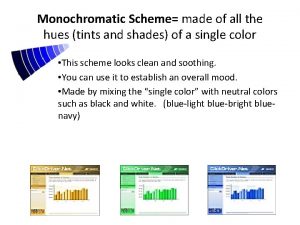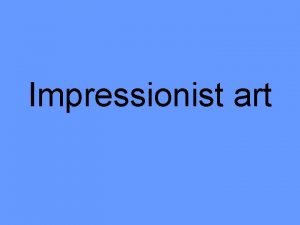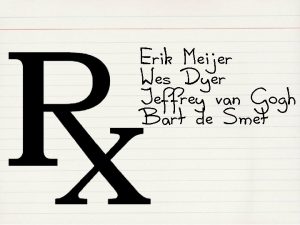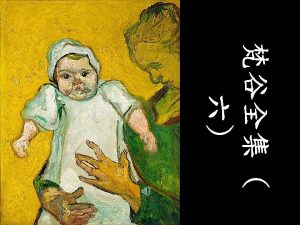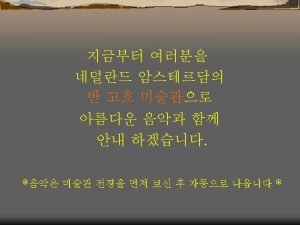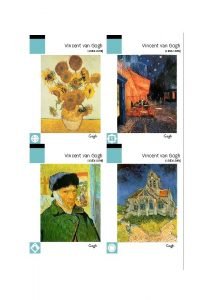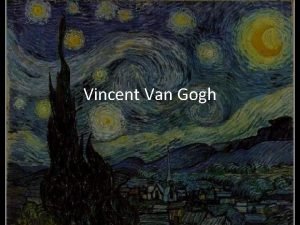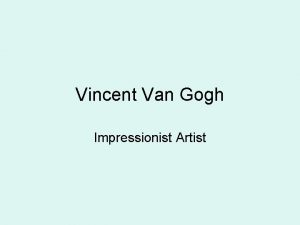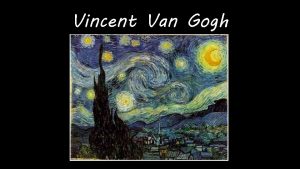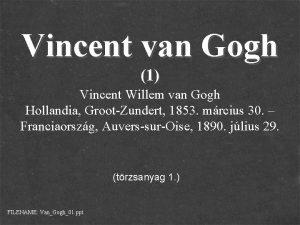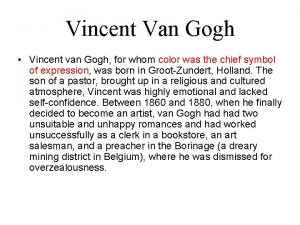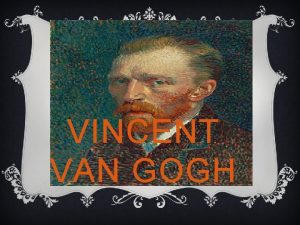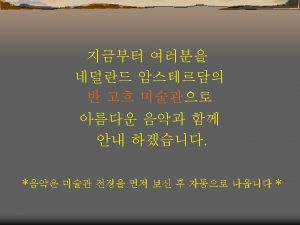Vincent van Gogh Vincent van Gogh Known as


























































- Slides: 58


Vincent van Gogh

Vincent van Gogh Known as the father of Expressionism

Expressionism A style of art that used distorted form and arbitrary color to bring out inner emotions and feelings.

Expressionists wanted the viewer to react to their work and become an active participant in the process of their art.

Look at this self portrait by Vincent van Gogh

How do you think he might be feeling?

What do you think might have happened to put him in this mood?

Which color stands out the most in this work?

Why do you think we use the term “blue” for times when we’re feeling sad or depressed?

How much do you think the color contributes to the mood?

Now how do you think he might be feeling?

What do you think might have happened to put him in this mood?

What has changed to make you feel differently?

Here is another self portrait by van Gogh

Which color is dominant in this work?

Which color is dominant in this work? Dominance: A principle of design when one element (line, shape form, value, color, texture) has controlling Influence in a work.

Which color is subordinate in this work?

Which color is subordinate in this work? Subordinate: When an element is secondary to the dominant element and is used to compliment it and make the work more visually exciting.

How do the subordinate colors enhance the work?

How much do you think color contributes to the mood of a work? Did you know? The color red can actually increase blood pressure? Amazing!

The Psychology Of Color

The Psychology Of Color As you can now see, color can really affect the way we feel about something. Here are some things about color that can help you make some choices as an artist.

Cool colors have low energy and warm colors have high energy.

Both warm and cool colors can be negative or positive. For example: Warm: might be angry (neg) or enthusiastic (pos) Cool: might be depressed (neg) or peaceful (pos)

Can you come up with some of your own Examples of warm and cool colors that might Represent both high and low energy moods?

3 ways that color affects our moods: 1. Universally 2. Culturally 3. Personally

Universal Colors Affect people innately (ie. Red actually increases your heart rate).

Cultural Colors are connected to a custom (ie black is a solemn color in the western world because it is worn at funerals).

Personal Colors affect people because of their unique experiences (ie. My room was painted blue when I was little so blue always makes me feel safe).

Think back to the paragraph you wrote earlier. Knowing what you know now, which color might you choose to make dominant in your work?

At the end of your paragraph, write down: • the name of the color • Whether it represents a universal, cultural or personal color. • Your justification in choosing it.

The element of TEXTURE can also be used to enhance a mood.

Texture An element of art that refers to the way something feels.

Implied Texture that looks like it would feel a certain way

Is van Gogh’s texture actual or implied?

For you, what is the mood of this painting?

How does the texture contribute to this feeling?

Practice and review

Dominant color? Subordinate? Mood?

Dominant color? Subordinate? Mood?

Dominant color? Subordinate? Mood?

Expressive Portrait

What we’ve done so far: • Discussed the element of color and how it affects mood • Analyzed the work of Vincent van Gogh • discussed the principles of dominance and subordination • Developed and practiced different oil pastel techniques

3 Main Points Covered: 1. The element of color can be used to create different moods and feelings in a composition. 2. Dominance and subordination can be used to enhance mood and add visual interest to a composition. 3. Pastel techniques when layered carefully can produce rich textures to: enhance moods and feelings create a rich surface that is visually exciting!

Objectives What you will be able to do: Use color and pastel techniques effectively to create an expressive mood in a composition that focuses on dominance and subordination.

Grading Criteria: • Effective use of the element of color in creating mood (be able to explain your choices) • Use of the principle of Dominance and subordination • Use of layers to produce rich implied textures • Control of materials • Effective use of time – On task behavior – Reflective paragraph – Technique sheets

end










 Vincent van gogh lebenslauf
Vincent van gogh lebenslauf Where was vincent van gogh born
Where was vincent van gogh born Vincent van gogh quotes about death
Vincent van gogh quotes about death Vincent van gogh solrosor
Vincent van gogh solrosor Starry nights song
Starry nights song Postimpresionistas
Postimpresionistas Vincent willem van gogh
Vincent willem van gogh Impressionalism
Impressionalism Emil lee
Emil lee Vincent van gogh champ de blé aux corbeaux
Vincent van gogh champ de blé aux corbeaux Starry night over the rhone pronunciation
Starry night over the rhone pronunciation La noche estrellada
La noche estrellada Picasso self portrait
Picasso self portrait Postimpressionist artist. *
Postimpressionist artist. * Van go or van goff
Van go or van goff Don mclean vincent
Don mclean vincent Vincent van gogh expressionisme
Vincent van gogh expressionisme An der schwelle der ewigkeit
An der schwelle der ewigkeit Van gogh and gauguin friendship
Van gogh and gauguin friendship Zundert casa van gogh
Zundert casa van gogh Kartoffelspiserne
Kartoffelspiserne Zitno polje sa vranama
Zitno polje sa vranama Upstairs
Upstairs Quando e dove nasce l'impressionismo
Quando e dove nasce l'impressionismo Van gogh e o expressionismo
Van gogh e o expressionismo Atividade cores primarias e secundarias
Atividade cores primarias e secundarias The primary colors
The primary colors Silent night van gogh
Silent night van gogh Van gogh kunststil
Van gogh kunststil Vincent langlois cumming
Vincent langlois cumming Silent night van gogh
Silent night van gogh Van gogh billiard parlor at night
Van gogh billiard parlor at night Van gogh of a billiard parlour at night
Van gogh of a billiard parlour at night Zitno polje sa cempresima
Zitno polje sa cempresima Silver thorn of bloody rose
Silver thorn of bloody rose Silver thorn of bloody rose
Silver thorn of bloody rose Arte van gogh
Arte van gogh Van gogh giapponismo
Van gogh giapponismo Monet van gogh museum
Monet van gogh museum Dyad color scheme
Dyad color scheme Silent night van gogh
Silent night van gogh Van gogh universo
Van gogh universo Jean francois millet el sembrador
Jean francois millet el sembrador Delia florea
Delia florea Van gogh ritratto di pere tanguy
Van gogh ritratto di pere tanguy Van gogh post impressionism
Van gogh post impressionism Diamond painting
Diamond painting Argenteuil 1874 by van gogh
Argenteuil 1874 by van gogh Dr. gachet van gogh
Dr. gachet van gogh Van gough austin
Van gough austin Courtesan van gogh
Courtesan van gogh The night cafe van gogh
The night cafe van gogh El último cuadro de van gogh
El último cuadro de van gogh Van gogh peignant des tournesols
Van gogh peignant des tournesols Van gogh monochromatic
Van gogh monochromatic Elbow impressionism
Elbow impressionism Bart dyer
Bart dyer Rijksmuseum otterlo
Rijksmuseum otterlo Flowering plum orchard van gogh
Flowering plum orchard van gogh


